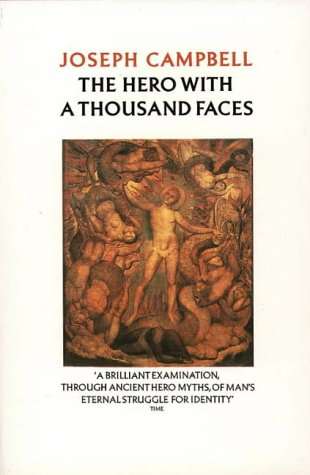Published by Fontana Harper collins, 1993, softcover, illustrated, 416 pages, condition: as new.
Despite their infinite variety of incident, setting, and costume, the myths of the world offer only a limited number of responses to the riddle of life. In this fascinating and influential book, Joseph Campbell presents the composite hero. Apollo, the Frog King of the fairy tale, Wotan, the Buddha, and numerous other protagonists of folklore and religion enact simultaneously the various phases of their common story. The relationship of their timeless symbols to those discovered in dream by contemporary depth psychology is taken as a starting point for interpretation. The psychological view is then compared with the words of such spiritual leaders as Moses, Jesus, Mohammed, Lao-tse, and the 'Old Man' of the Australian tribes. From behind a thousand faces the single hero looks out, archetype of all human myth.
Written in 1948, Hero With A Thousand Faces is only slightly younger than I am. I was introduced to it in my mid-twenties, almost half a century ago. But upon re-reading it I find it as revelatory as it was then. By avoiding the idea of faith entirely, Campbell keeps alive a religion of hope. Hero With A Thousand Faces is a theology of the God of hope. It is a description of this God as a way of perceiving both the world and oneself. It presents, therefore, not an aesthetic idea of God, but God as an aesthetic, the Divine Aesthetic.
Campbells Divine Aesthetic is divine because it is the one, shape-shifting yet marvellously constant story that we find, together with a challengingly persistent suggestion of more remaining to be experienced than will ever be known or told. It is both universal and infinite. It applies in every culture and in every age. It is constantly the same and yet manifests itself in uncountably many ways, in art, music, dance, science, technology, literature, and of course religion. Its scripture includes fairy tales and learned treatises. Its followers are everyone who can speak, and even infants and the infirm who cant. We live in a world of symbols and complex arrangements of symbols we call stories. Some we create for ourselves, some that others create we are born into, and some are essentially eternal. These latter appear to arrive with our genes; they are quite literally bred into us. Befitting their status, these symbols are beyond our control. Hence they appear omnipotent in the specific sense that the Divine Aesthetic includes all aesthetics (including itself, in defiance of pedestrian, finite, human logic). And, who knows, perhaps they are as powerful as they appear. We have no way of assessing their scope or the full character of their existence. They are part of us yet entirely separate. They unite us but allow us to think we are entirely independent of one other. They themselves are not divine, as Plato thought; but they are manifestations of the incomprehensibly divine made suitable for human consumption.

